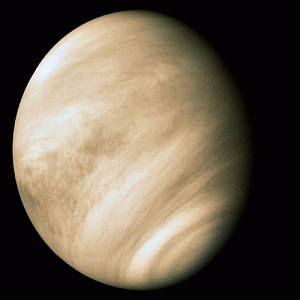Planet Venus

Named after the Roman goddess of Love, Venus is the 2nd closest planet to the Sun and orbiting it every 224.7 Earth days. It is also the only planet in the Solar System to be named after a female figure. Venus is also the brightest natural object in the night sky other than the Moon. Since Venus is an inferior planet from Earth, it never strays far away from the Sun. Venus is also often known as the Morning Star or Evening Star as it reaches its maximum brightness either shortly before sunrise or shortly after sunset.
Venus is categorized as a ‘terrestrial planet’ and is referred to as Earth’s sister planet due to the similarity in gravity, size and bulk composition. The planet is covered in layers of sulfuric acid and reflective clouds opaque in color which prevents its surface to be seen from space in visible light. This made it a great subject of speculation and studies until some of its mysteries were shed in the 20th Century through planetary science.
Planet Venus contains the densest atmosphere amongst all the terrestrial planets. The atmosphere contains mostly carbon dioxide since it has no carbon cycle to return the carbon to the surface and rocks and no organic life to absorb it in biomass. The planet becomes extremely hot that the oceans similar to that of earth have all evaporated with only a dusty and dry desert-like scape with rocks. The best theory is that the evaporated oceans and water have been dissociated and without a planetary magnetic field, the hydrogen would have been blown away by the solar wind into interplanetary space.
Venus has not been mapped extensively to date. It was only done so in the last 22 years or so by Project Magellan with evidence to show that there exists volcanic presence. The sulfur in the air have been taken for studies but it still remains a mystery as to why there is no evidence of lava flow to accompany the visible caldera. The number of impact craters are low, indicating that the surface is relatively young; about half a billion years old.
The temperature in Venus is constant due to its isothermal surface. It maintains a temperature that is constant day and night between the equator and the poles. The clouds on Venus are very much capable in producing lightning which is similar to that of Earth’s. It created controversy early on when the first suspected bursts were detected and was only clearly proven in 2006-2007 when Venus Express detected whistler mode waves; clear signatures of lightning.
There are currently ongoing missions to Venus such as that of the Venus Express which was launched on Nov 9 2005. It was taken for detailed studies of the clouds and atmosphere as well as to map the planet’s plasma environment and other surface characteristics such as the temperatures. Due to the hostile conditions, our current technology disallows for the possibility of colonization of Venus. However, there have been increased speculations of building ‘floating cities’ in Venus’ atmosphere in the future.
October 10th, 2010 at 11:47 am
gooood
January 10th, 2011 at 4:03 pm
Thanks this helped alot. Wooo! Go Venus 😀